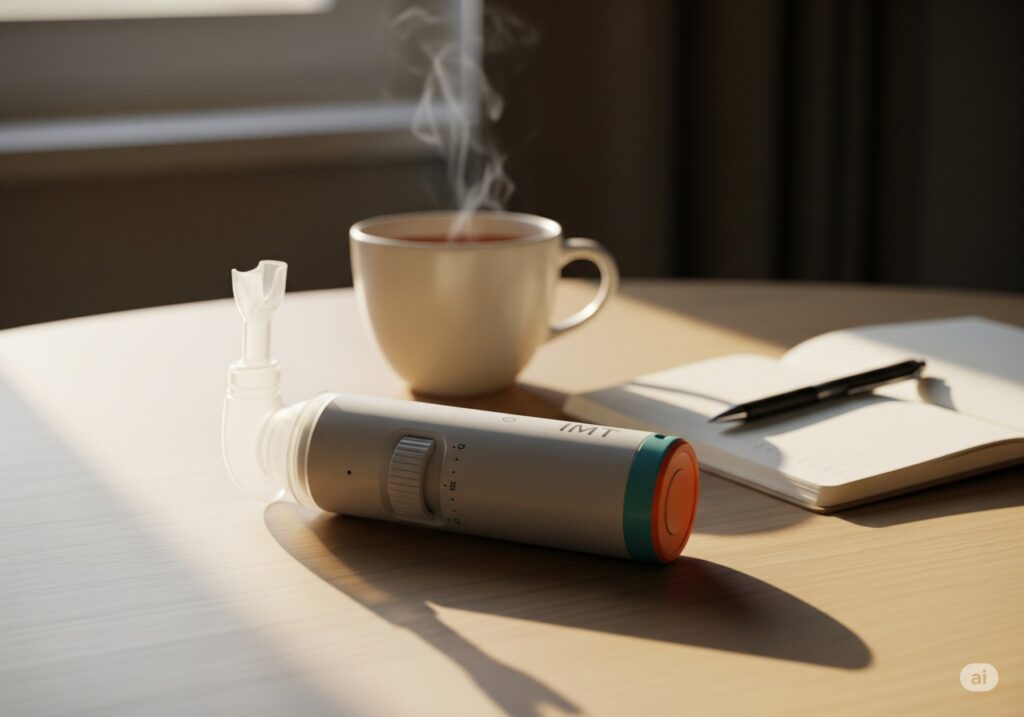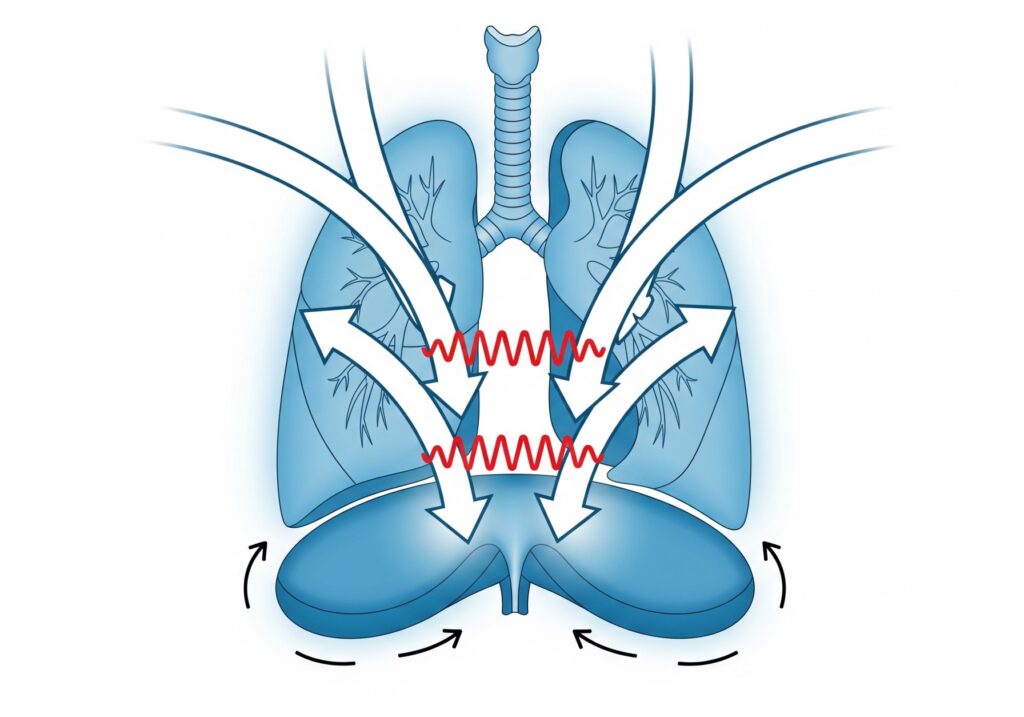
Person practicing the 5-minute breathing habit at home
A 5-minute breathing habit can lower blood pressure and sharpen brain function. Learn how to do it, why it works, and what the science says.
Not meditation, not exercise: The 5-minute habit that improves heart and brain health
Most advice says “meditate more” or “work out longer.” But there’s another option. It takes about five minutes. It is not meditation. And it’s not a workout in the usual sense. It’s high-resistance inspiratory muscle strength training—think of it as the 5-minute breathing habit that conditions your breathing muscles and, in the process, supports your heart and your brain. PubMed, PMC
What is the 5-minute breathing habit?

This habit uses a small handheld device that you breathe in through against resistance. You’ll take about 30 strong inhales (with normal, relaxed exhales) once per day. Total time? Roughly five minutes. It’s simple. It’s measurable. And it’s easy to slot between meetings or while your tea cools. The most studied version is called Inspiratory Muscle Strength Training (IMST). PMC
Quick note: This is not mindfulness or slow, meditative breathing. It’s resisted breathing—more like strength training for the diaphragm and accessory breathing muscles. That’s why researchers compare it to a workout, even though it’s just five minutes. University of Colorado Boulder
Why the 5-minute breathing habit matters for the heart
Randomized, sham-controlled studies in adults with above-normal blood pressure show that six weeks of IMST (30 breaths/day, 6 days/week) can:
- Lower systolic blood pressure by ~9 mmHg (on average).
- Improve endothelial function (how well blood vessels dilate).
- Boost nitric oxide bioavailability and reduce markers of oxidative stress. PubMed
Those are not trivial changes. A drop of 5–10 mmHg in systolic blood pressure is linked to meaningful reductions in cardiovascular risk. And because IMST enhances endothelial function, it supports healthier arteries beyond the blood pressure number alone. For a plain-language overview, see the University of Colorado Boulder summary of the trial: “5-minute breathing workout lowers blood pressure as much as exercise or drugs.” University of Colorado Boulder
Harvard Health has also highlighted the approach, noting that a few minutes of daily breath training may help lower blood pressure, though larger studies are still underway. That’s a fair, science-grounded caveat. Harvard Health
Why the 5-minute breathing habit matters for the brain

Your brain needs steady blood flow and flexible vessels. In a 2023 trial, researchers found that time-efficient, high-resistance IMST increased cerebrovascular reactivity—essentially, the brain’s ability to adjust its blood vessel diameter in response to changing carbon dioxide levels. Even better, the study reported a modest uptick in episodic memory after six weeks. That suggests a vascular route to sharper cognition. PubMed
Mechanistically, this lines up: IMST improved markers tied to nitric oxide in brain endothelial cells (those that line blood vessels), which helps vessels dilate when needed. Healthier vessels, better regulation. Better regulation, better support for attention and memory under daily stress. PubMed
How to start the 5-minute breathing habit (step-by-step)
Before you begin: If you have heart or lung disease, very high blood pressure, dizziness, or recent surgery, talk to your clinician first. Most trials included adults with “above-normal” blood pressure but screened for safety.
- Get a device. Search for “inspiratory muscle trainer.” Pick one with adjustable resistance and clear instructions. (The research protocols used high-resistance settings, individualized to your strength.) PMC
- Set aside five minutes. Mornings work well. But any consistent time is fine.
- Warm-up inhale or two. Sit tall. Relax your shoulders and jaw.
- Do 30 resisted inhales.
- Seal lips around the mouthpiece.
- Inhale strongly through the device.
- Exhale normally (off the device).
- Keep a steady rhythm. Aim to finish in ~5 minutes. PMC
- Track it. Jot down the day and resistance setting. Nudge resistance up as instructed by the device guide once the set feels easy.
- Stay consistent. Most benefits in the studies appeared after 6 weeks, with effects partly maintained even after pausing. PubMed
The 5-minute breathing habit and your routine
Because it’s brief, you can stack the 5-minute breathing habit onto an existing anchor: after brushing your teeth, before your commute, or right before lunch. Short, repeatable actions stick. Moreover, adherence in trials was ~95%, far higher than many exercise programs. That’s a big deal for real-world health gains. PubMed
Pair the 5-minute breathing habit with smart basics
This habit is powerful. Yet, it’s even better with the fundamentals:
- Follow a blood-pressure-friendly pattern (e.g., DASH-style eating and less sodium).
- Move your body most days, even in short bouts.
- Sleep on a schedule; manage stress.
For context on lifestyle and blood pressure management, see current AHA guidance and clinician resources. AHA Journals
But wait—how is this “not meditation” and “not exercise”?
Good question. Meditation trains attention and awareness. It can use the breath but does not require resistance. Exercise, as most of us mean it, raises heart rate through whole-body movement. IMST is neither. It’s a targeted, resisted-breathing drill that you can finish in under ten minutes. It complements both mindfulness and physical activity, but it doesn’t replace medical care or prescriptions when they’re needed. PMC
Who should be cautious?
- Anyone with uncontrolled hypertension, significant cardiovascular or pulmonary disease, recent thoracic/abdominal surgery, or a history of spontaneous pneumothorax should get medical advice first.
- If you feel light-headed, chest pain, or unusual shortness of breath, stop and seek care.
These warnings align with how participants were screened and monitored in clinical trials. PubMed
What results can you expect—and when?
If you practice daily for six weeks, you may see lower systolic blood pressure, better vessel function, and possibly sharper memory, especially if your baseline blood pressure is above normal. Some benefits appear to persist for weeks after stopping, though staying consistent makes sense. As always, individual responses vary. PubMed+1
Sources and further reading
- Randomized controlled trial: Time-Efficient Inspiratory Muscle Strength Training Lowers Blood Pressure and Improves Endothelial Function (J Am Heart Assoc, 2021) — open access summary and data. (https://www.ahajournals.org/doi/10.1161/JAHA.121.020980) AHA Journals, PMC
- University explainer: “5-minute breathing workout lowers blood pressure as much as exercise or drugs” — University of Colorado Boulder news release. (https://www.colorado.edu/today/2021/06/29/5-minute-breathing-workout-lowers-blood-pressure-much-exercise-drugs) University of Colorado Boulder
- Brain benefits trial: Time-efficient, high-resistance inspiratory muscle strength training increases cerebrovascular reactivity in midlife and older adults (Am J Physiol Heart Circ Physiol, 2023). (https://pubmed.ncbi.nlm.nih.gov/37682232/) PubMed
- Clinician perspective: Harvard Health — “Breath training may lower blood pressure.” (https://www.health.harvard.edu/heart-health/breath-training-may-lower-blood-pressure) Harvard Health
- Guidance context: AHA scientific statements and hypertension resources for clinicians and patients. (https://www.ahajournals.org/) AHA Journals
Bottom line
You asked for something quick, practical, and not meditation or conventional exercise. The 5-minute breathing habit—high-resistance inspiratory training—fits. It is brief. It is portable. And in carefully controlled trials, it improved heart markers like blood pressure and endothelial function and boosted brain-related vascular responses (with a hint of memory improvement). Add it to your day. Pair it with smart basics. Then, check your progress in six weeks.
Medical Disclaimer
This article is for educational purposes only and is not a substitute for professional medical advice, diagnosis, or treatment. Always seek the advice of your physician or another qualified healthcare provider with any questions you may have regarding a medical condition, before starting a new health routine, or if you experience any concerning symptoms. Never disregard professional medical advice or delay seeking it because of something you have read here.
Call to Action
Ready to try the 5-minute breathing habit? Start small, track your progress, and talk with your healthcare provider about whether this method is right for you. If you found this article useful, share it with a friend, and subscribe for more science-backed health insights that fit into everyday life.








2 thoughts on “5-Minute Breathing Habit for Stronger Heart and Brain”